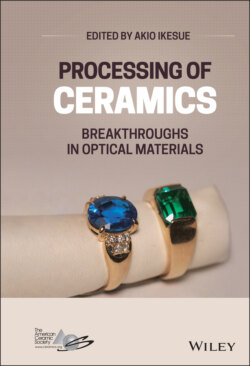Читать книгу Processing of Ceramics - Группа авторов - Страница 26
2.3.5 Fiber Ceramics as Laser Gain Media
ОглавлениеIn general, glass materials have large σ (stimulated emission cross section) and τ (fluorescence lifetime) and are materials that have a large energy storage capacity and large output of laser power. However, due to their low thermal conductivity and low repetition rate of continuous‐wave and pulse oscillation, crystalline materials are industrially being applied. The above problem can be solved by adding a laser‐active element to a glass fiber having a diameter of about several tens of μm or smaller, and the laser emitted from the fiber can simplify the optical system or it can be mounted on a robot arm and so on. Hence, the technical range is different from the lasers that use bulky solid gain media. However, regarding the fiber laser, if a crystalline fiber (ceramic) can be made instead of glass fiber, the laser gain length (fiber length) of the fiber can be shortened and the heat dissipation characteristics will be excellent, so further improvements in laser performance are highly expected.
H. Kim et al. made a slurry with a planetary mill using YAG, Ho2O3 powder, an organic binder, and ion‐exchanged water as a solvent and extruded the slurry at a pressure of 20–35 MPa using a nozzle with a diameter of 50 μm to form a fiber‐like green body [18, 19]. After drying at room temperature, it was calcined at 600 °C to remove organic components and then sintered in a vacuum furnace at 1700–1800 °C, followed by annealing at 1400–1500 °C to produce a fiber‐like sintered body. Since the surface of the obtained fiber is uneven, the surface is polished. The outer periphery of the polished fiber is coated with glass powder and then heat‐treated for cladding.
In Figure 2.19a–c, SEM micrographs of the surfaces of the polycrystalline YAG fibers with different degrees of surface polishing are shown, and it is noted that the surface roughness is finished with up to RMS = 0.03 μm. Figure 2.19d is a cross section of the as‐sintered sample, and the fiber diameter is about 20 μm, and it is a dense microstructure composed of grains of several μm.
Figure 2.19 SEM micrographs of the surfaces of the polycrystalline YAG fibers with different degrees of surface polishing: (a) shows the surface of the as‐sintered fiber and (c) is further polished than (b). Surface roughness values of (a) and (c) are given in root mean square (RMS). (d) SEM micrograph of the cross section of the polycrystalline Ho:YAG fiber before surface polishing.
Source: Kim et al. [19].
Figure 2.20 Output power as a function of input power for the HR + Fresnel configuration during power scaling efforts.
Source: Kim et al. [19].© 2017, The Optical Society.
Figure 2.20 shows the input and output characteristics when a laser test was performed using a Tm:glass fiber laser with a wavelength of 1908 nm. The output level was several tens of mW, and the slope efficiency was low at 1–4%. However, the glass cladding fiber successfully oscillates a laser beam with a wavelength of 2091 nm with a slope efficiency of 7%. Although the scattering of the ceramic fiber material has not been sufficiently controlled, this is the first successful example using fiber‐shaped ceramics.
